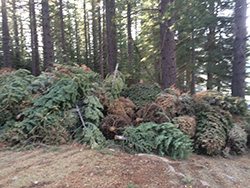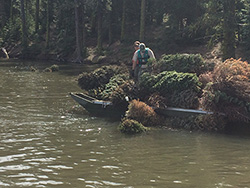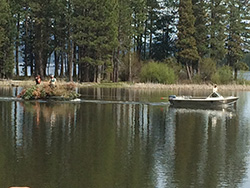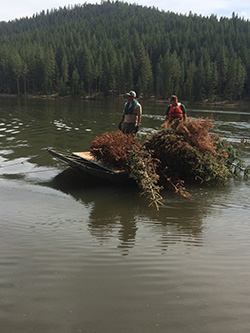



Christmas can be the gift that keeps giving -- to anglers and fish alike.
In the north state, CDFW fish habitat technicians oversee the collection of discarded Christmas trees, which will be used to build underwater habitat structures for local waterways. Long after they’ve brightened holiday homes, these trees will provide shelter for juvenile warmwater fish species -- and ultimately will create better fishing opportunities for anglers.
According to Joseph Rightmier, a fish habitat supervisor with CDFW’s Fish Habitat Improvement Shop in Yreka, the trees are weighed down with cables and submerged, creating a refuge for juvenile fish, including Largemouth Bass and crappie.
“The fish get into the voids within the structure, which gives them some protection. And when you attract smaller fish, you also end up attracting larger, catchable fish, which hang out close to the surface and wait for a meal,” Rightmier said.
“Divers have determined that fish start congregating in and around the structures within a day or two of the habitat structures being installed. They’re hot real estate in the water!”
One of the largest efforts to collect and “upcycle” trees is conducted by Rightmier’s team in Siskiyou County. Last summer, staff used trees collected after the 2017 holidays to create and then place 22 habitat structures into Green Springs Reservoir in Modoc County. The habitat structures were comprised of approximately 200 recycled Christmas trees and small junipers. The Christmas trees were collected at drop-off locations in the cities of Alturas and Yreka, and the small junipers were harvested in the Modoc National Forest.
In 2018, Rightmier said, the Yreka fisheries habitat technicians also used trees to build fish habitat structures in three other locations: Juanita Lake, Orr Lake and Trout Lake. Similar projects have also been conducted at Lake Shastina and Dorris reservoir in the past.
Further south, CDFW’s Redding office is also overseeing a Christmas tree collection operation. The tentative collection location will be in the town of Chester, and the trees will be used for a project in Lassen County.
“Generally, we prefer hardwoods when doing habitat projects, but we do use Christmas trees when they’re available,” explained Monty Currier, an environmental scientist with CDFW’s Reservoir Program. “The trees would go a landfill to be chipped otherwise, and we believe that recycling is a better idea. And people are happy to help CDFW with this kind of habitat improvement project – who doesn’t like the idea of making our fisheries better?”
Currier is currently working with a local bass fishing group and county officials to determine a specific tree dropoff point.
Donated trees should not be flocked, and should be stripped of lights, tinsel and ornaments. The trees are usually transformed for their new use within a couple of months, before they dry out completely.
“Our fish habitat shops enjoy doing this type of project, and it makes a real difference in how successful anglers are,” Currier says. “Everybody wins – not just the fish!”
###
Interested in recycling your Christmas tree in Siskiyou, Plumas or Modoc counties? Drop-off locations for Christmas trees will be located near the CDFW offices in Alturas (702 East Eighth St.) and Yreka (at the corner of Ranch and Oregon streets, due west of the CDFW yard). In Chester, the location has not yet been determined, but you can call the main office at (530) 225-2300 for information closer to the holiday.
CDFW Photos. All Photos: Fisheries biologists placing recycled Christmas trees into Mountain Meadows Reservoir, Lassen County, to create habitat for juvenile fish.